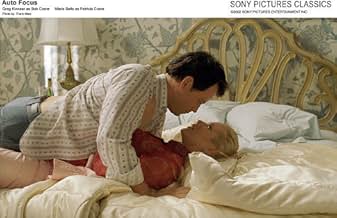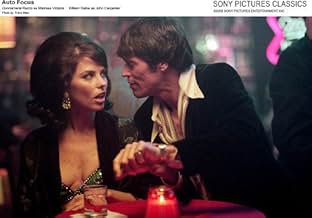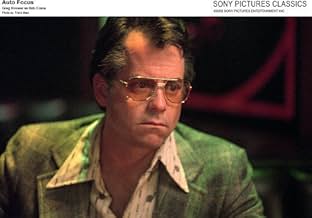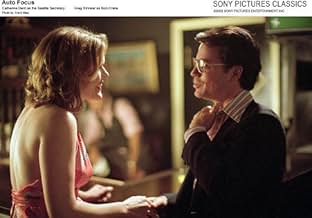The life of TV star Bob Crane and his strange friendship with electronics expert John Henry Carpenter.The life of TV star Bob Crane and his strange friendship with electronics expert John Henry Carpenter.The life of TV star Bob Crane and his strange friendship with electronics expert John Henry Carpenter.
- Awards
- 6 nominations total
Michael E. Rodgers
- Richard Dawson
- (as Michael Rodgers)
DonnaMarie Recco
- Melissa
- (as Donnamarie Recco)
- …
- Director
- Writers
- All cast & crew
- Production, box office & more at IMDbPro
Featured reviews
Wow, is Greg Kinnear nothing short of amazing in this film or what! An incredible performance as Bob Crane, seriously virtuoso. When, towards the end, he visits his agent and is all messed up, and starts saying "sex is normal. I'm normal" - Kinnear reaches a pinnacle in his young film acting career. I have always felt that actors ascend to the next level of craft and stardom when they breakthrough with a biographical role; see - Denzel Washington in Malcom X, Ben Kingsley in Ghandi, Robert Downey Jr in Chaplin, Peter O'Toole in Lawrence of Arabia. And now Greg Kinnear has made that leap with Auto Focus, a well-crafted and seductive film by Paul Schrader, Hollywood's last bastion of non-sugar coated filmmakers. Basically the story of Hollywood's most intriguing unsolved murder, Auto Focus also pulls back the curtain on "good guy" Bob Crane's lecherous and painfully discombobulated private and secret life. What is also amazing about this film is how is records the birth of video and the VCR. Bob Crane turns out to be one of the pioneer "users" of this technology. When we see or hear video, video cameras, or VCRs, we probably automatically think of home movies, recording episodes of Star Trek, or the Star Wars prequels' lack of cinematic quality. When Bob Crane heard about video cameras and VCRs, he automatically thought of sex. Though the film makes no mention of it, it is quite prophetic in showing us how the technology of video created hard-core pornography and turned it into a billion dollar industry. If you think about it, nothing has profited more from video than porno, and nothing ever relied so dearly on video like porno. Bob Crane instinctively felt this, though he never was a pornographer, so to speak; he knew that sex and video can go hand in hand. Unfortunately, this was also his downfall. Like most Paul Schrader writ or directed films, by the end you get that queasy feeling, the feeling you get at the end of Goodfellas, the feeling of sadness that this great ride is over and the feeling of emptiness and loss that all that greatness came crashing down. Bob Crane's descent into moral madness can be sickening, especially when juxtaposed with Hogan's Heroes. I almost felt the desire to shower, to cleanse myself after viewing this film. I love movies that produce reactions from me, movies that linger for days. This is one of them.
10waltergl
I believe that this was the most severely underrated film of 2002, and it was also my personal favorite for a great year in film. Now, I sincerely doubt that many moviegoers would consider this one of the year's best, or even a great film, so this comes with a tentative recommendation. I wouldn't recommend this movie to just anybody, but I feel that fans of the prior work of Scorsese and Schrader will consider this a worthwhile endeavor. With this work Schrader continues his legacy of disturbed, distorted, doomed men whose selfishness and shallow nature ultimately lead them to great suffering as they destroy those who come close to them. Greg Kinnear's Bob Crane joins the likes of DeNiro's Jake LaMotta in Raging Bull, Gene Hackman's Harry Caul in The Conversation, and Nick Nolte's Wade Whitehouse in another Schrader masterpiece, Affliction. These are sad, empty men, for whom we can only half-sympathize; we feel for them because we suffer, but we condemn them because they force themselves and others to suffer.
The film follows the sexual exploits of Greg Kinnear as Bob Crane, the real-life star of Hogan's Heroes, who during and after the show became a full-blown sex addict, ruining two marriages and possibly sabotaging his career in the process. Willem Dafoe is John Carpenter (no, I know what you're thinking, and he's not), Crane's partner in crime who lacks Crane's charisma with women but is fed some scraps by Crane in return for his extensive knowledge of and access to video equipment. Crane's fetish is using the home video cameras to record his sexual trysts, which he reviews over and over again, looking for something that we can't see, and that he probably can't see either.
Kinnear and Dafoe's performances alone are worth the price of admission. This is the best, boldest, and most nuanced work that Kinnear has ever done. His performance is all subtlety and detail; he introduces Crane as a regular, aw shucks family man, but as the movie progresses we gradually see the facade fall as his quiet desperation and insatiable sexual appetite begin to consume him. Not content to go over the top and yell at the top of his lungs to be effective, Kinnear instead puts on a fake smile and charms with a velvety voice while openly degrading and hitting on women. The effect is one of the most genuinely creepy performances ever committed to film. Dafoe is the perfect companion to Kinnear's subtle predator; Carpenter is a pathetic loser, easily angered and easily hurt. He gets angry, yells, and does all of the things that you've seen Dafoe do in his other portrayals of guys you wouldn't want to meet in a dark alley, or a lighted one, for that matter. It's effective elsewhere, and it's effective here. Together, these men form a pair so utterly joyless and shallow that just seeing them on-screen together made my stomach churn. Their dialogue is only incidental, usually reminiscing on previous sexual escapades or planning new ones, but it's the little tics, gestures, Kinnear's untouchable confidence foiled by Dafoe's insecurity, Kinnear's hidden hunger foiled by Dafoe's overt desperation, that give these scenes their resounding power.
Not to shortchange Schrader's direction, though, which as usual is right on target for the material. He begins in a brightly colored, idealized suburban landscape, filled with all of the usual imagery you'd expect in this sort of light-hearted period and location. Then, slowly, he slides into darker territory, carrying us into the decadent seventies, breaking shots into shorter lengths, shaking the camera, depicting with his cinematography and editing the fall of his protagonist. Admittedly, the techniques Schrader employs here to depict Crane's breakdown have been used many times before, but I still found them extremely effective here.
For the last thirty minutes of the film, I felt genuinely ill; not because I thought the projector was out of focus, as many have complained, but because Schrader and Kinnear were taking me to a dark place and immersing me in it. As I said before, this type of film is not for everybody, but for those interested in the dark side of man, this film is not to be missed. I think that at the very least, the merit of these depressing morality tales is that they provide an exact blueprint of the way not to live our lives. I suppose that showing Crane checking himself into therapy and dealing with his problems and utimately healing himself would be valuable as well, but it wouldn't make for a good film, or a true one. Some people argue against the very existence of this type of movie. My response to them is that in real life for every strong-willed person who solves their problems and triumphs over adversity, there is another loser who ultimately fails to deal with life and implodes upon their own insecurity and weakness. Until this changes, someone needs to continue making these films.
The film follows the sexual exploits of Greg Kinnear as Bob Crane, the real-life star of Hogan's Heroes, who during and after the show became a full-blown sex addict, ruining two marriages and possibly sabotaging his career in the process. Willem Dafoe is John Carpenter (no, I know what you're thinking, and he's not), Crane's partner in crime who lacks Crane's charisma with women but is fed some scraps by Crane in return for his extensive knowledge of and access to video equipment. Crane's fetish is using the home video cameras to record his sexual trysts, which he reviews over and over again, looking for something that we can't see, and that he probably can't see either.
Kinnear and Dafoe's performances alone are worth the price of admission. This is the best, boldest, and most nuanced work that Kinnear has ever done. His performance is all subtlety and detail; he introduces Crane as a regular, aw shucks family man, but as the movie progresses we gradually see the facade fall as his quiet desperation and insatiable sexual appetite begin to consume him. Not content to go over the top and yell at the top of his lungs to be effective, Kinnear instead puts on a fake smile and charms with a velvety voice while openly degrading and hitting on women. The effect is one of the most genuinely creepy performances ever committed to film. Dafoe is the perfect companion to Kinnear's subtle predator; Carpenter is a pathetic loser, easily angered and easily hurt. He gets angry, yells, and does all of the things that you've seen Dafoe do in his other portrayals of guys you wouldn't want to meet in a dark alley, or a lighted one, for that matter. It's effective elsewhere, and it's effective here. Together, these men form a pair so utterly joyless and shallow that just seeing them on-screen together made my stomach churn. Their dialogue is only incidental, usually reminiscing on previous sexual escapades or planning new ones, but it's the little tics, gestures, Kinnear's untouchable confidence foiled by Dafoe's insecurity, Kinnear's hidden hunger foiled by Dafoe's overt desperation, that give these scenes their resounding power.
Not to shortchange Schrader's direction, though, which as usual is right on target for the material. He begins in a brightly colored, idealized suburban landscape, filled with all of the usual imagery you'd expect in this sort of light-hearted period and location. Then, slowly, he slides into darker territory, carrying us into the decadent seventies, breaking shots into shorter lengths, shaking the camera, depicting with his cinematography and editing the fall of his protagonist. Admittedly, the techniques Schrader employs here to depict Crane's breakdown have been used many times before, but I still found them extremely effective here.
For the last thirty minutes of the film, I felt genuinely ill; not because I thought the projector was out of focus, as many have complained, but because Schrader and Kinnear were taking me to a dark place and immersing me in it. As I said before, this type of film is not for everybody, but for those interested in the dark side of man, this film is not to be missed. I think that at the very least, the merit of these depressing morality tales is that they provide an exact blueprint of the way not to live our lives. I suppose that showing Crane checking himself into therapy and dealing with his problems and utimately healing himself would be valuable as well, but it wouldn't make for a good film, or a true one. Some people argue against the very existence of this type of movie. My response to them is that in real life for every strong-willed person who solves their problems and triumphs over adversity, there is another loser who ultimately fails to deal with life and implodes upon their own insecurity and weakness. Until this changes, someone needs to continue making these films.
This is a movie about a man's downfall; in this case, sex. I saw this right after 'Requiem for a Dream'(I guess I was in an addictive mood). This is a sad movie, but not on par with 'Requiem'. I never knew the sordid details about 'Col. Hogan', but this movie laid it out for me. The acting is very good. As other's viewers have noticed, the cinematography and music matches the decline of Crane's life. I was very depressed near the end. There is an obvious implication of his friend Carpenter in his murder, and outside of a court of law, many people would believe it. It's like a weak Oliver Stone/JFK, but still believable. Kind of like a required homework assignment that they may never get credit for, yet execute at 100 percent and show their merit. It wasn't a box office movie, but I believe it's worth watching, and it is exemplarary work by the actors. Maybe it needed more supporting character development, maybe longer screen shots.
As anyone who is reading this knows, this was the story of TV's Bob Crane, star of "Hogan's Heroes," a popular show in the 1960s. The story of Crane, the one that makes him a subject of a major motion picture of his life, are two things: 1 - the good-guy TV hero was, behind the scenes, a huge sex addict; 2 - he was murdered, with no one ever convicted of the crime. To this day, it is still unsolved.
The movie hints very strongly that the killer was Bob Carpenter, played here by Willem Dafoe. Carpenter was a close friend of Crane's. Greg Kinnear does a credible job of portraying the television star.
However, the part about Crane's murder is only dealt with in the final minutes of the film! That was very disappointing and I was hoping to find out something or at least be given more information. They just kind tacked this on the end of the film.
Most of the film was about Crane's and Carpenter's escapades with women.....lots of women, beautiful and big-chested women, which you see in abundance in this film. Dafoe is the sleazy friend who introduces Crane to the beginning of the VCR age. That led to a whole bunch of sex-on-film and really whetted Crane's big sexual appetite.
Anyway, for people who watched "Hogan's Heroes," and there were plenty, this is a bio of him and perhaps, for those who know nothing about his death, who killed him.
The movie hints very strongly that the killer was Bob Carpenter, played here by Willem Dafoe. Carpenter was a close friend of Crane's. Greg Kinnear does a credible job of portraying the television star.
However, the part about Crane's murder is only dealt with in the final minutes of the film! That was very disappointing and I was hoping to find out something or at least be given more information. They just kind tacked this on the end of the film.
Most of the film was about Crane's and Carpenter's escapades with women.....lots of women, beautiful and big-chested women, which you see in abundance in this film. Dafoe is the sleazy friend who introduces Crane to the beginning of the VCR age. That led to a whole bunch of sex-on-film and really whetted Crane's big sexual appetite.
Anyway, for people who watched "Hogan's Heroes," and there were plenty, this is a bio of him and perhaps, for those who know nothing about his death, who killed him.
Let's face it: Bob Crane was a lightweight actor, whose one-note portrayal of Col. Hogan in the unlikeliest sitcom hit of the 60s made him a household name. Personally, I never understood the appeal of either "Hogan's Heroes" or its star.
Greg Kinnear taps into Bob Crane, though, from the first frame.
The viewer learns that the pre-Hogan Crane was an affable, lovable kind of guy whose LA radio show had a big following. His agent sees him as a combination of Jack Lemmon and Jack Benny, a potential star of fluffy sex comedies with a benign sort of sex appeal and a knack for snappy one-liners All of that was a vast overestimation of Crane's talents.
Crane reveled in the fame that "Hogan" brought him, but he seems never to have taken a long view of his career. When the show ended he was left rudderless and idle, having slowly cut the ties that bound him to ordinary life -- his work, a stable home life, and his religious faith.
While he coasted, Crane took advantage of the easy, cynical charm he conveyed on screen to lure women. By the dozen. I think he probably enjoyed being the least likely man in Hollywood to skulk strip clubs looking for prey, and to devote thousands of yards of videotape to his exploits with them. But his naivete is telling: Crane allows himself to be led into a netherworld by John Carpenter, (Willem Dafoe), who teaches him that putting sex on film is more fun than having it. And there is a brief scene where Crane meets a dominatrix and reveals himself as not quite savvy enough to play this game to win.
Addictions tend to claim those who are on the way up or the way down. Even before Peg Entwistle famously jumped off the Hollywoodland sign in 1922, there have been scores of aspirants to fame or has-beens whose compulsions have killed them, leaving their work on screen the least compelling,least-remembered part of their lives.
Greg Kinnear taps into Bob Crane, though, from the first frame.
The viewer learns that the pre-Hogan Crane was an affable, lovable kind of guy whose LA radio show had a big following. His agent sees him as a combination of Jack Lemmon and Jack Benny, a potential star of fluffy sex comedies with a benign sort of sex appeal and a knack for snappy one-liners All of that was a vast overestimation of Crane's talents.
Crane reveled in the fame that "Hogan" brought him, but he seems never to have taken a long view of his career. When the show ended he was left rudderless and idle, having slowly cut the ties that bound him to ordinary life -- his work, a stable home life, and his religious faith.
While he coasted, Crane took advantage of the easy, cynical charm he conveyed on screen to lure women. By the dozen. I think he probably enjoyed being the least likely man in Hollywood to skulk strip clubs looking for prey, and to devote thousands of yards of videotape to his exploits with them. But his naivete is telling: Crane allows himself to be led into a netherworld by John Carpenter, (Willem Dafoe), who teaches him that putting sex on film is more fun than having it. And there is a brief scene where Crane meets a dominatrix and reveals himself as not quite savvy enough to play this game to win.
Addictions tend to claim those who are on the way up or the way down. Even before Peg Entwistle famously jumped off the Hollywoodland sign in 1922, there have been scores of aspirants to fame or has-beens whose compulsions have killed them, leaving their work on screen the least compelling,least-remembered part of their lives.
Did you know
- TriviaThe leather jacket that Greg Kinnear wears while playing Bob Crane in the Papa Schultz (1965) scenes of this movie is the one that the real Crane actually wore during the filming of that TV series. Crane's son Robert David Crane loaned the jacket to Kinnear for this movie. Prior to the original "Hogan's Heroes" show, Frank Sinatra wore this exact same jacket in L'express du colonel von Ryan (1965).
- GoofsThere is a glimpse of the famous Capitol Records building painted silver. At the time of the film, it was actually painted black to resemble a stack of records.
- Quotes
Bob Crane: I think it's perfect for me. I mean, this character Hogan, he's quick on his toes, he's hip, he's a con artist. I don't wanna jinx it, but I think it's what I've been working toward my whole career!
Anne Crane: Really? You've been working towards a Holocaust comedy?
Bob Crane: Ann!
Anne Crane: What, Bob?
Bob Crane: Please, not in front of the children! They look up to me!
Anne Crane: They're small. They look up to everyone.
- Alternate versionsThe following deleted scenes appear on the DVD:
- Victoria finds Bob's body.
- Hogan's Heroes Montage
- Bob unloads drums and some dirty magazines fall out.
- Anne and Bob talking by the pool.
- Anne in the darkroom.
- ConnectionsFeatured in Auto Focus: Featurette (2002)
- SoundtracksSnap!
Written by Paul Schrader and Angelo Badalamenti
Performed by David Johansen (as Buster Poindexter)
Produced by Brian Koonin
- How long is Auto Focus?Powered by Alexa
Details
Box office
- Budget
- $7,000,000 (estimated)
- Gross US & Canada
- $2,063,196
- Opening weekend US & Canada
- $123,761
- Oct 20, 2002
- Gross worldwide
- $2,704,951
- Runtime1 hour 45 minutes
- Color
- Sound mix
- Aspect ratio
- 1.85 : 1
Contribute to this page
Suggest an edit or add missing content









































